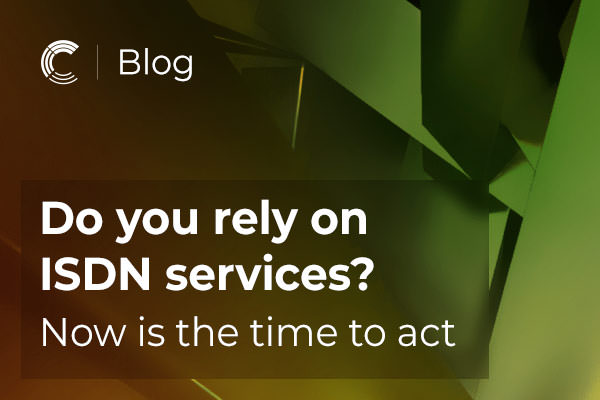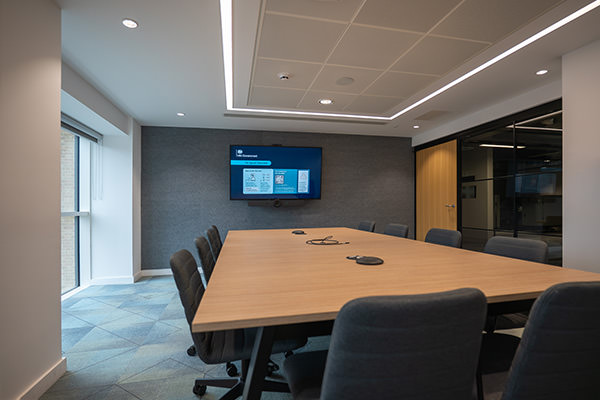SIP Managed Services Overview
Cinos’ SIP Trunking services enable your office phone system or cloud unified communications and telephony service, such as Microsoft Teams or Webex, to be connected to the public telephone network, allowing a user to make and receive telephone calls.
If you are seeking professional guidance for your project and would prefer to speak directly with an expert, please do not hesitate to get in touch. Our team are on hand to discuss your requirements so why not get the ball rolling today.
Bundle Offer
Inclusive Unlimited SIP Calls to UK Mobile (07) and UK National (01/02/03) Numbers*
Bundle Offer
Inclusive Unlimited SIP Calls to UK Mobile (07) and UK National (01/02/03) Numbers*
SIP is now rapidly replacing traditional ISDN and PSTN services
With legacy ISDN and PSTN circuits no longer orderable as of 2020, and the Public Switched Telephone Network (PSTN) being switched off entirely in the United Kingdom in 2027, SIP Trunking solutions offer the modern telephony means to connect your calls between your phone system or cloud service, and external users.
PSTN to SIP and ISDN to SIP
With these deadlines looming, businesses whose telephony contract is up for renewal need to start exploring alternatives now. Even if you have a few years left on your contract with PSTN and ISDN lines being switched off in 2027 you must start thinking about how you’ll make the move to SIP/VoIP solutions.
And this is where Cinos comes in. Whether you are looking to move from PSTN to SIP, ISDN to SIP or to a hosted IP phone system our experts are here to help. We have more information below on our SIP services but please do not hesitate to get in touch. Sometimes it is easier speaking with an expert and we would be happy to discuss the options you have.
Pay as you use and bundled minute options
Our SIP Trunking services provide both pay as you use and bundled (inclusive) minute options, allowing for complete flexibility and cost predictability in how you consume the service. We also offer a free cost analysis service where we will assess your current call and line rental spend and provide predictive cost savings on moving to our service.
We offer connectivity from a single, up to unlimited SIP channels for concurrent calls, and the flexibility to scale the number of channels based upon demand.
Our bundled minute offer includes unlimited SIP calling minutes to UK National (numbers starting 01/02/03) and UK Mobile (UK mobiles starting 07)*.
*Subject to fair use policy
For many years the Integrated Services Digital Network (ISDN) has been the standard and trusted connectivity to the PSTN for PBX environments. Even with the introduction of IP based phone systems, ISDN was still the go-to choice to provide either the main PSTN connectivity, or a backup to the newer options of Session Initiation Protocol (SIP). However, Openreach will be switching off the UK’s PSTN by 2027 and migrating all customers to internet enabled telecommunications.
In the Cinos Blog, Jono Darlington, Solutions Architect at Cinos explains why organisations across the UK must act now if they are still relying on ISDN services. With Openreach announcing they will stop selling PSTN and ISDN services to new customers in September, Darlington highlights how Cinos can assist organisations with our SIP Trunking Service to ensure continuity of service and take advantage of integrated communications, including messaging, presence, and video.
SIP Trunking Managed Services
Cinos offers two flavours of SIP Trunking Managed Services:
SIP Trunking Components
As with many SIP Managed Trunking Services in the marketplace,
Cinos’ SIP Trunking Managed Service has two primary components:
Managed
Session Border Controllers (SBCs) are provided and fully managed as part of the service. Cinos will work with the customer to integrate the service with the customer’s PBX or unified communications environment.
Unmanaged
The customer provides their own Session Border Controller (SBC) and connects our service to their existing PBX or unified communications environment.
SIP Channels
A SIP channel provides the ability to carry a single concurrent inbound call from an external caller or make an outbound call to an external caller.
Numbers
We can provide new geographic (01 and 02) and non-geographic (03, 05 and 08) numbers, or port existing number allocations to our service.
SIP Trunking Managed Services
Cinos offers two flavours of SIP Trunking Managed Services:
Managed
Session Border Controllers (SBCs) are provided and fully managed as part of the service. Cinos will work with the customer to integrate the service with the customer’s PBX or unified communications environment.
Unmanaged
The customer provides their own Session Border Controller (SBC) and connects our service to their existing PBX or unified communications environment.
SIP Trunking Components
As with many SIP Managed Trunking Services in the marketplace,
Cinos’ SIP Trunking Managed Service has two primary components:
SIP Channels
A SIP channel provides the ability to carry a single concurrent inbound call from an external caller or make an outbound call to an external caller.
Numbers
We can provide new geographic (01 and 02) and non-geographic (03, 05 and 08) numbers, or port existing number allocations to our service.
Centralised, Consolidated Billing and Reporting
Cinos’ SIP Trunking services use Prism from Tiger, a powerful analytics plaform for peace of mind and control.
Cinos’ SIP Trunking services include a powerful analytics platform from Tiger, called Prism. Prism provides centralised, consolidated billing and reporting, giving you peace of mind and control, enabling your data to help drive better business decisions. Prism analytics includes:
Prism empowers you to love data with intuitive analytics and tools. With its easy-to-use dashboards, data is accessed, defined and visualised quickly. Graphs, tables, charts – however you like to see your information, it can be displayed in a range of formats. The benefits of Prism are:
How we differ
Cinos offers complete flexibility in how we deliver your calls. We can deliver your number ranges (DDIs) to multiple sites to provide for business continuity and high availability; or split your calls between legacy phone system and cloud service, such as Microsoft Teams or Webex for example.
We also license SIP channels centrally, meaning that you pay for the total number of concurrent calls you require over all platforms, rather than worrying about how many primary / active or backup channels you require.
SIP Trunking Service Features & Benefits
| Feature | Benefit |
|---|---|
| Optional fully managed service, beyond standard support and maintenance | A single point of access for:
|
| Business Continuity and Disaster Recovery improvements | Resilient paths and diverse technology options enable protection from outages. Achieved by allowing calls to be delivered to, or made from alternative locations automatically |
| Cost avoidance with modern connectivity options | Significant cost savings may be made when employing modern IP network-based services such as SIP over traditional ISDN or analogue connections |
| Connectivity and scalability options | Calls may be delivered over the Internet or private data access services allowing for resilience and dynamic scalability of services |
| Support for Microsoft Teams Direct Routing | As Microsoft Teams Direct Routing Partners our service utilises Microsoft approved Cisco SBCs to support Microsoft Teams Direct Routing. |
| Flexible call delivery options | Deliver the same number ranges (DDIs) over multiple sites or services |
SIP Trunking
Frequently Asked Questions
Yes. Crestron delivers an intelligent, integrated room booking experience through Microsoft Teams Panels, bringing a seamless and familiar Microsoft Teams interface to your workplace.
Users can quickly locate available spaces, check availability, and confirm bookings with ease. A built-in proximity sensor enables a touch-free experience, while crisp screen resolution ensures clear visibility. Rooms can be reserved from your desktop, mobile, or directly at the panel, with real-time availability, meeting details, and cleanliness status clearly displayed. Third-party app integrations further enhance functionality, supporting services such as catering, concierge, and floorplans. Setup is simple, with Power over Ethernet (PoE+) installation and secure, web-based configuration.
Crestron offer a wide range of scheduling solutions which include:
Absolutely. Cinos provides comprehensive support and maintenance for Crestron Microsoft Teams Rooms to ensure your meeting spaces remain reliable, secure, and fully functional. We design a maintenance plan tailored to your organisation’s requirements, whether that involves a single room or an entire estate.
Our services include:
With Cinos managing your Crestron Microsoft Teams Rooms, you can be confident that your technology will perform at its best, supporting productive, uninterrupted collaboration for all users.
The move from ISDN to SIP trunking is a key step in preparing for the BT PSTN switch-off, scheduled for January 2027. As traditional telephony infrastructure is phased out, organisations must transition to IP-based services to maintain voice communications.
Cinos experts Jono Darlington and Richard Evans explore the key benefits of moving to SIP — particularly for critical calling environments — in the following blog articles:
In summary, switching to SIP delivers a range of benefits for organisations of all types, including:
A SIP trunk service enables voice calls to be made over the internet rather than through traditional telephone lines. It connects your organisation’s phone system or cloud unified communications service, such as Microsoft Teams or Webex, to the Public Switched Telephone Network (PSTN) using Session Initiation Protocol (SIP), allowing you to make and receive external calls through your existing IP-based infrastructure.
SIP trunking supports modern business communications by offering:
Cinos is a Tier 1 SIP provider delivering a fully managed, end-to-end IP telephony platform with no reliance on third parties, so you benefit from lower call costs, reduced line-rental fees and predictable CAPEX. Our single-provider model ensures clear accountability and automatic rerouting in the event of connectivity issues, keeping your communications live even if a cable is accidentally damaged.
Key advantages include:
Whether you’re a critical-calling environment or any other organisation seeking reliable, high-quality telephony, Cinos combines technology, experience and accountability to keep your teams connected.
Yes, SIP services are ideally suited to hybrid and remote working environments. By routing voice calls over the internet, SIP allows users to stay connected from any location using their preferred communication platform. Cinos delivers secure, high-quality SIP connectivity that supports flexible working and integrates seamlessly with Microsoft Teams, Webex, and other collaboration tools.
Cinos integrates SIP services with Microsoft Teams or Webex using Direct Routing or cloud-based SIP trunking. For Microsoft Teams, this involves using certified Session Border Controllers (SBC) to connect Cinos’ SIP trunks to Microsoft 365, enabling users to make and receive external calls directly through the Teams interface. For Webex, Cinos connects SIP services via Webex Calling using a supported SBC to deliver reliable PSTN connectivity. Cinos works closely with your IT team to ensure seamless integration, optimal call quality, and alignment with your organisation’s telephony requirements.







